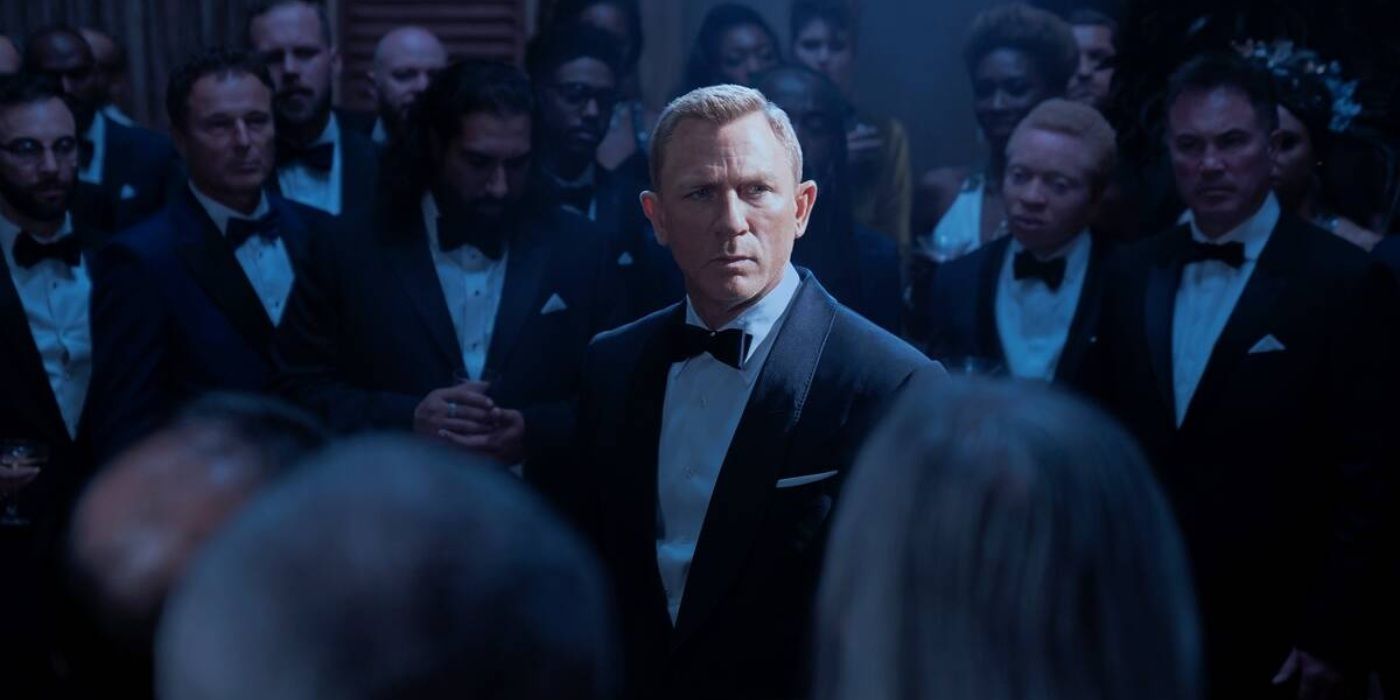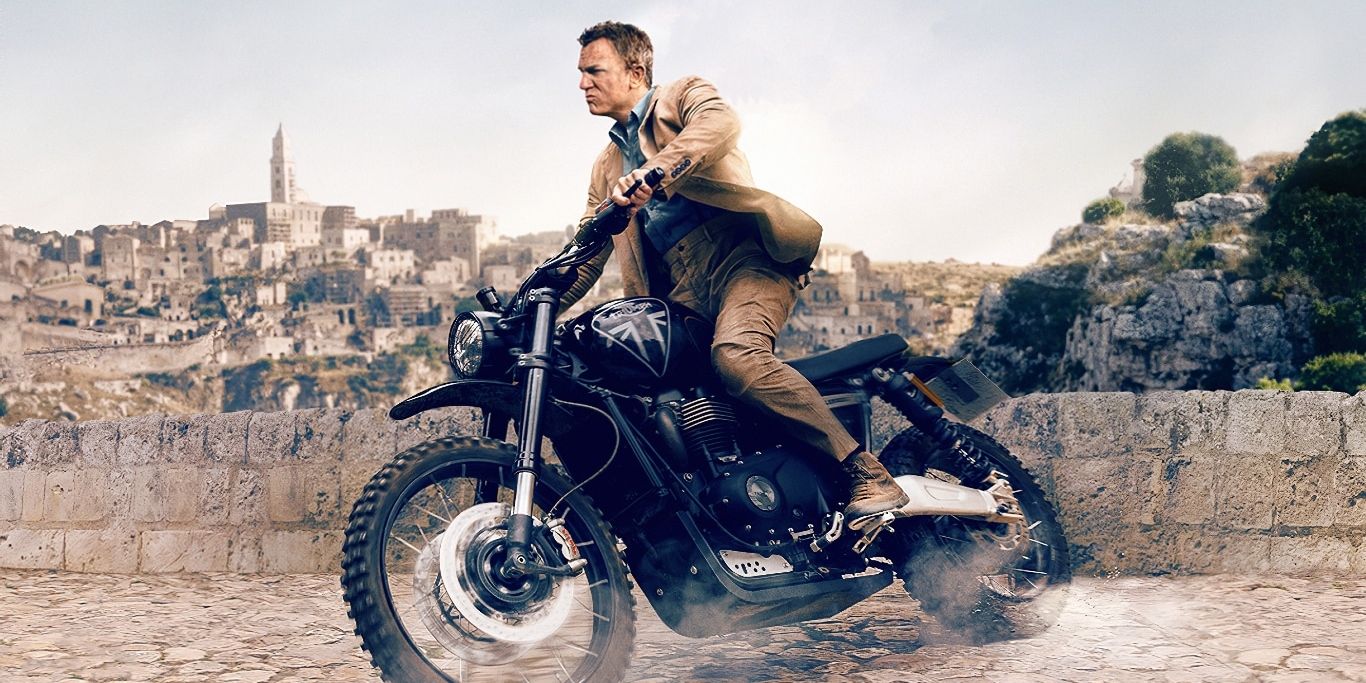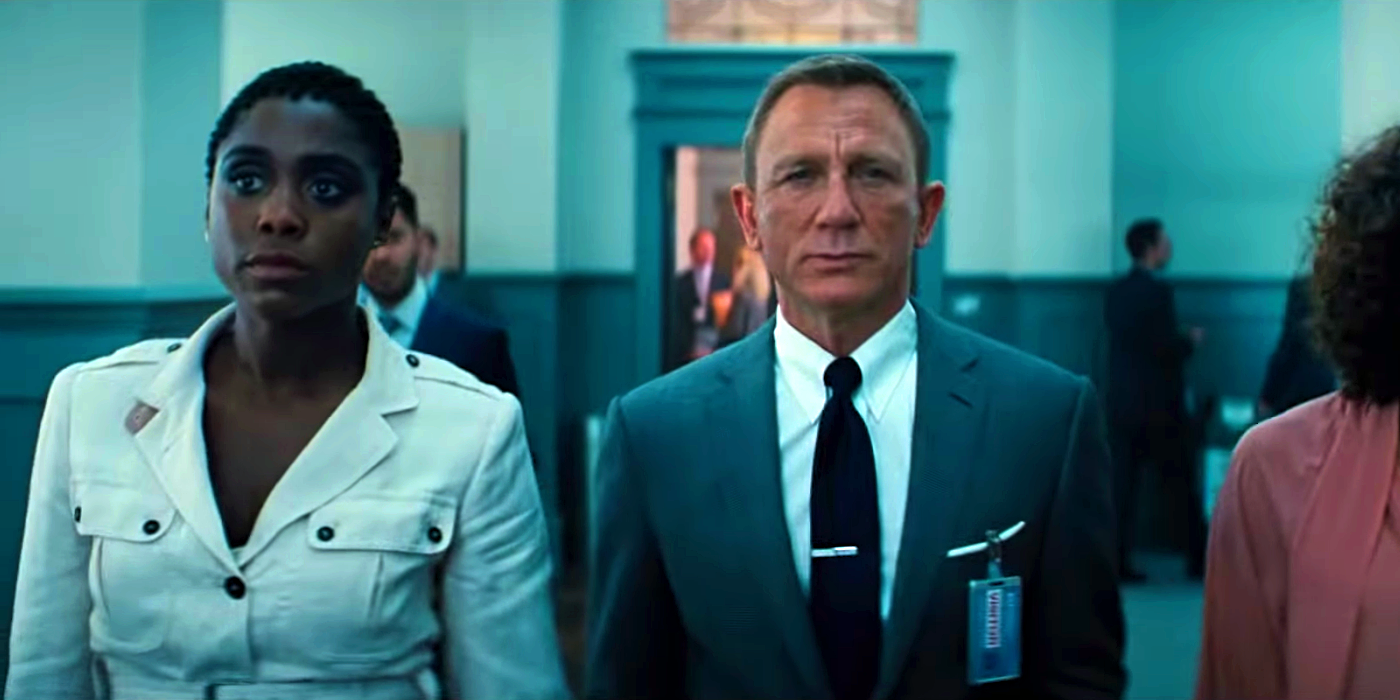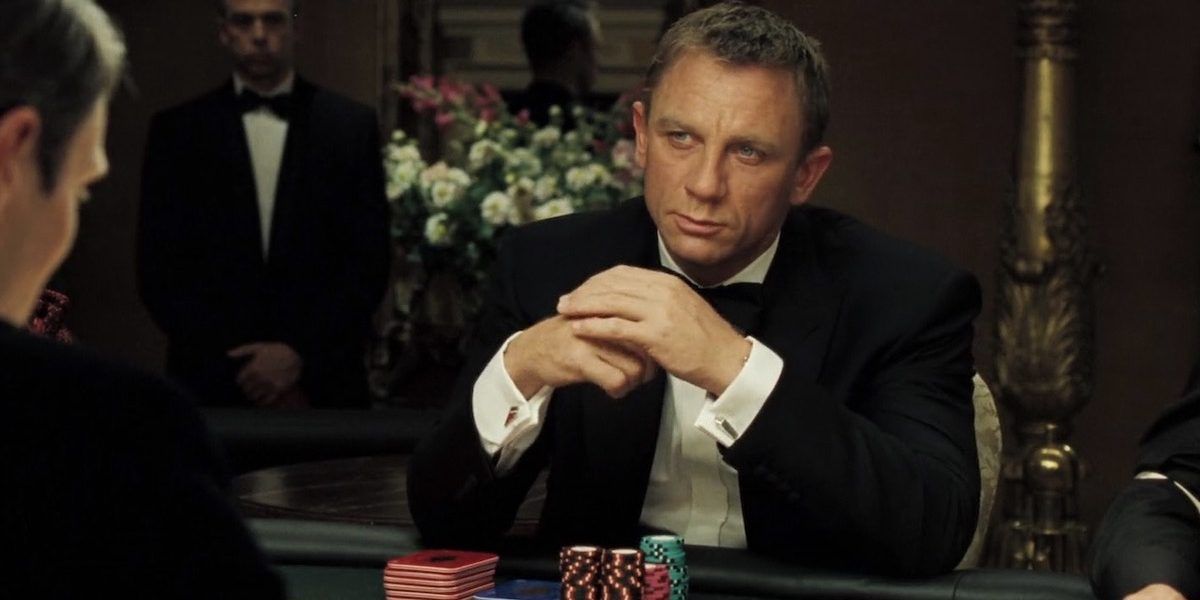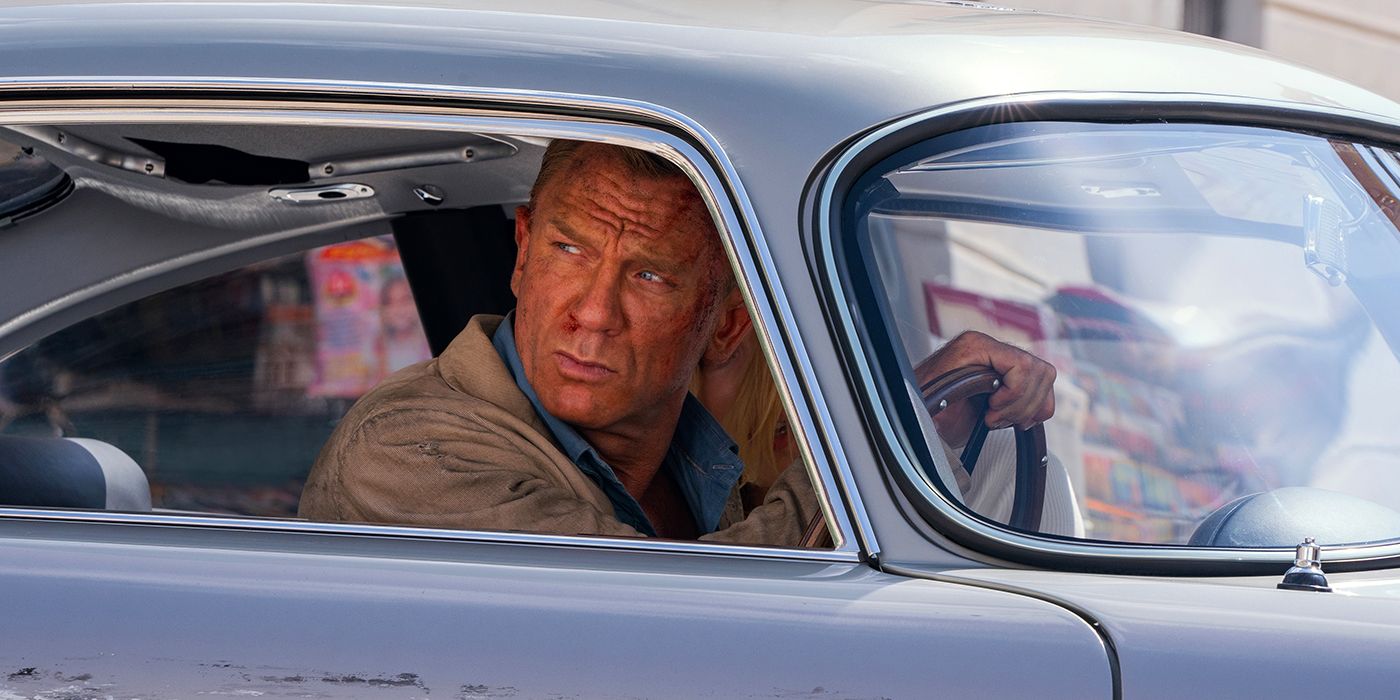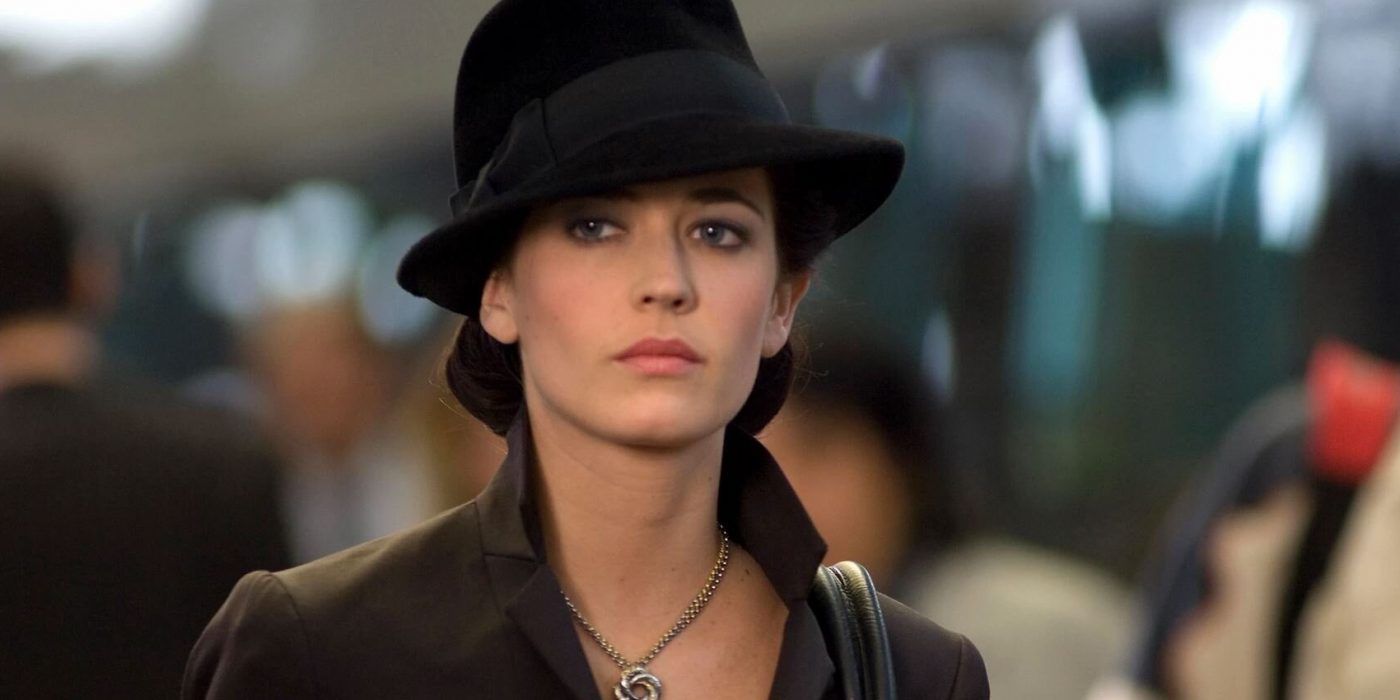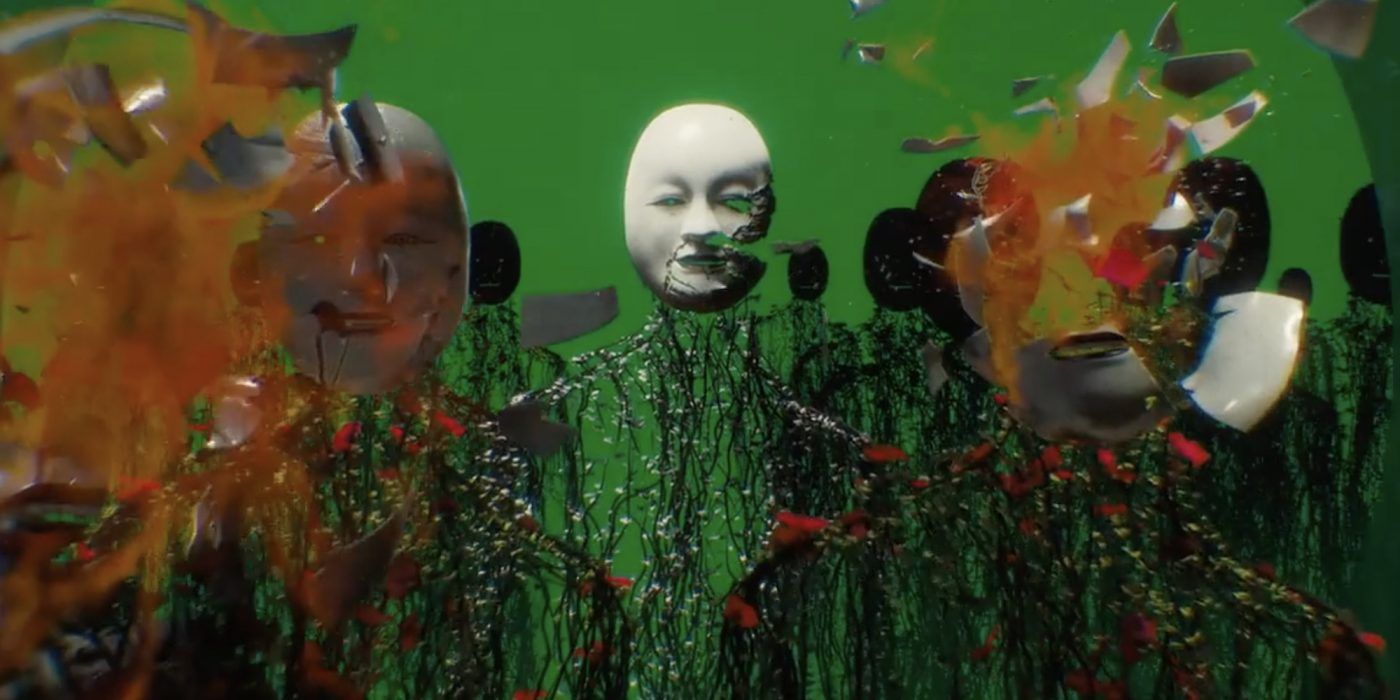James Bond films have historically had highly stylized, deeply layered opening credits. As a rule, the sequences are famous for making art with many of Bond's signature elements: guns, bullets, cars, sexy silhouettes. But as individual entries, each credit sequence is designed to tell the audience something about the movie to come: everything from the original song instrumentals and lyrics to the color choices and repeating symbols comments on the film’s plot, theme, and character arcs, and No Time To Die is no exception.
Set to Billie Eilish's ethereal song, No Time To Die's opening credits have guns and cars, which look at some points like toys and other times like realistic weapons, bodies in stark silhouette and the flesh, bold greens, reds, and blues, and repeating symbols of time, from clock gears to hourglasses. But perhaps more than any other Bond film, its credits also look backward through other 007 entries, incorporating images, themes, and characters from Craig's entire run.
Looking back is fitting because No Time To Die is arguably the most retrospective of all Bond films, examining not only Craig’s influence on the franchise but the legacy of the character both within the franchise’s world and the real world. No Time To Die’s story considers this Bond’s legacy, how his past haunts him, and what he thinks about his line going forward through his lover and child as well as the next 007. The film also cheekily nods to the fervor around what the Bond casting and assignment mean and how any deviation from a specific 'type' is treated: Craig’s casting caused an uproar because he was blonde, and casting Lashana Lynch as a Black female 007, even as a sidekick, is certainly an intentional commentary. The credits take all this and more and encapsulate it in a three and a half minute stunner of a sequence, exploring through word, music, and imagery what the film itself is about and many of the changes James Bond went through over the 15 years and five films he was embodied by Craig.
Billie Eilish's Grammy-winning song lyrics were analyzed thoroughly even before the film premiered, with speculation on whether its blunt words foreshadowed betrayal, a reemergence of past lovers or villains, or perhaps a metaphorical or even literal death. The answer is "all of the above," and the credits sequence touches on them all as well.
Cary Joji Fukunaga is a stylish, highly visual director, and this shows in the title sequence, designed by eight-time veteran Daniel Kleinman. The sequences start as a train moves left to right, out of the station and into the future. The colored dots that collect to obscure the train station reference the Bond franchise's first-ever opening credits, again looking to the film series' past before focusing on the present film. Next, kaleidoscoping abstract shapes resolve into a clear shape of a woman trapped in the ice, referencing the film's opening scene of a young Madeleine Swann. The idea of being trapped is very much a theme in No Time To Die: whether it's trapped literally in a sinking ship or surrounded by enemy agents; trapped metaphorically in the past by lovers and betrayals; or both, in the case of Blofeld and Safin, who trap both Bond and Swann literally in rooms and on an island and psychically within memories and terror of losing loved ones.
The woman’s silhouetted image grows smaller until the ice block is incorporated into the shape of a trident. A second trident also appears in frame, held by a statue of a soldier; while a trident has many meanings and significances, it’s often a symbol of Poseidon or the sea, the water of which is significant not only in the frozen opener but the finale where Bond is surrounded by the sea on a small island. At first – fitting with the underwater location – the images are entirely blue. Subsequent closeups on the soldier statue begin to show a growing white spread of what looks like ice crystals but also signify contagion multiplying the way Safin’s nanobots might.
As the song lyrics announce, "the blood you bleed is just the blood you owe," the closeups begin blooming with red; the first is blood spreading across the soldier’s cheek, the second spreads across the shield. The shield's crosshatch pattern looks like a Union Jack, reminding the viewer that bloodshed is significant in terms of not only Bond’s personal history but the country he serves. The shield topples towards the camera and 'wipes,' everything fading to black and transitioning to the next scene. This 'cut to black' technique repeats throughout the credits sequence.
The next shot begins with the camera zooming in towards clockwork machinery, still mostly blue with red elements. The stark red lines look somewhat like clock hands or gunsight lasers, both of which make sense in the context of gears and Bond. But as they move, their tips are revealed to be heart-shaped, looking exactly like symbols on playing cards, which had a central role in Craig’s Bond debut, Casino Royale.
On two of the heart shapes appear a white figure and a black figure. These are the other two colors that make up playing cards, and of course, a swan (as in Madeline Swann) is often fully white. The white figure reaches out a hand, but their respective hearts are moving away from each other, like the way Bond and Swann come ever-so-close to being together several times but never manage. The camera cuts in closer to the two figures, revealing the black-silhouette is indeed a man, presumably Bond. Here, the colors take on another significance, signifying black and white morality and Bond’s dark-stained guilty conscience.
Jeffrey Wright’s name appears as the camera drifts downward into depths and fades to black, foreshadowing how the boat Leiter is on will sink and kill him. It's one of many moments that may seem insignificant when watching it the first time but have heavy import after watching the rest of No Time To Die.
As the camera has now indicated it is deep underwater, a bullet-riddled car sinks slowly down as Eilish sings, "I’ve fallen for a lie." In a series of shots, the camera follows the car falling through murky depths through the center of a clock face with red numbers and no hands. The clock symbolically strikes on the theme of time again, with the lack of hands indicating both timelessness and a lack of control over time depending on how the viewer reads it. Finally, the car crashes into a sandy floor, which seems to be an ocean; as it hits, the color transitions from blue to golds and yellows. As the scene grows lighter and more golden, it reveals the previous soldier statue, now prone and half-buried in the sands the car is now sinking into.
The camera pulls back to show a wider tableau of the ocean floor, and the black Bond silhouette shape from earlier appears and walks by the car, as well as the trident from earlier and a new symbol of a handgun. A pendulum swings through the scene, barely missing Bond; the pendulum is a weapon but also a symbol of an old-fashioned clock. As Eilish sings, "fool me once, fool me twice," the pendulum swings through a second time and hits the sandy 'ocean' floor, scattering sand and dissolving everything else into more sand, which begins to fall down through an hourglass.
The hourglass itself is also tumbling downward; as it falls away and the camera simultaneously retreats, the hourglass becomes a small timepiece falling through a spiral of handguns. The guns begin firing in rhythm, and their bullet trails create thin lines that make the spiral look like a double-helix. This is more than simple clever pattern creation: it brings back the theme of medical warfare, DNA changes, and nanobots, all of which are crucial not only to the plot but Bond's eventual demise.
Everything to this point has been fairly abstract; even the 3D images look more like toys or statues than realistic items. But as the DNA helixes spiral and violins sing, the camera follows several bullet shells ejected from the firing handguns, and for a brief moment, the trails trace a lifelike image against the green background. The face reveals itself for a moment to be James Bond then dissolves; the next sequence of lines forms into Madeleine Swann, who first appeared in Spectre, then as Eilish sings "faces from my past return," the lines form a clear, momentary glimpse of Vesper Lynd.
The credits sequence has multiple subconscious indicators of Lynd; scenes indicating sinking and underwater vistas are reminiscent of her death at the end of Casino Royale, and the two figures attempting to connect but tragically missing could have been Bond and Vesper as well as Bond and Swann, but this is the first explicit image of Bond's past lover and betrayer. Lynd’s face dissipates as quickly as it appears, but her memory colors the rest of the sequence the same way she haunts Bond’s psyche throughout No Time to Die.
Lines and dots converge as the camera zooms into a red dot, going through the bright red into another black screen and coming out to reveal a closeup of what looks to be marble, moves like fabric, then crystalizes into a closeup of a body, onto which are projected cherry blossoms. More intimate closeups of body parts follow – fingers, stomachs, thighs, the small of a back – and the body moves and flexes as red dots and blooming cherry blossoms multiply across the screen. Some of the twining cherry blossoms look like a double helix again but taken all together, the flowers and red dots insinuate beauty and growth as well as blood and death, all of which indicate change and the passing of time. The body sequence finishes on a marble closeup of a face, which could be the soldier statue from before. Cracks in the face indicate age and ravages of time, and through those cracks grow plants that sprout red, heart-shaped flowers, as the camera again fades to black.
The next sequence fades in on a small army of white masks akin to the mask Safin wears, each one of which has a 'body' made entirely of vines, twigs, and blooming red flowers. As the camera passes through this forest of spectres, the masks all begin to shatter into bright orange plumes. The bright white and orange blooms are bright and stark against the scene's green background, the colors together indicating something unnatural and poisonous.
The camera zooms through the mouth of one of the masks and comes abruptly up to the end of a solid white gun composed of a material that makes it look similar to the masks, which just disintegrated. The gun is being held by a black marble Bond statue that stands against a red background. Whether because it’s being fired or simply ravaged by time, the gun shatters, and the next cut is to a different angle that shows the hand holding the gun also shattering, revealing a blue powder in a similar way to the masks breaking and revealing orange. This shows that Bond and his nemesis may be similar in some ways, including their breaking.
The blue of the powder takes over the screen and transitions the sequence back to the underwater scene from before, which now contains a rising orange dot. At first glance, the orange circle looks like the sun, but it also signifies the film's final explosion, which consumes both the island and Bond. As the orange dot ascends, a gun buried in the ocean floor fires one last time, and its bullet shatters the image into kaleidoscoping blue and orange shapes, the refracted image mirroring the initial image which started the credits sequence, indicating everything eventually comes full circle.
Just as the initial dots and movement transitioned from the train station scene which preceded the credits, this final image turns into city lights and black mirrored walls and transitions directly into the establishing shot for the next scene. The opening seamlessly integrates itself into the film, a fantasy sequence that links directly to hard reality... and begins Bond's last mission.

